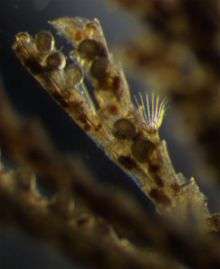Marine moss reveals clues to anti-cancer compound

An Oregon Health & Science University researcher believes the discovery of a gene cluster from a bacterium that protects a moss-like marine invertebrate from predators may be the first step toward engineering cancer-fighting drugs.
Margo Haygood, Ph.D., professor of environmental and biomolecular systems at OHSU's OGI School of Science & Engineering, has detailed her research team's discovery of the large gene cluster in a bacterium that protects the larvae of the bushy marine bryozoan Bugula neritina.
The bacterium, Endobugula sertula, acting as a symbiont to its bryozoan host, secretes a bioactive molecule that makes the poppy seed-sized larvae distasteful to predatory fish. But that molecule, known as a bryostatin, also confounds a variety of cancer cell lines.
"The larvae are covered with a skin of bryostatins," said Haygood, whose research was described recently in the Journal of Natural Products. "They need this kind of protection. We also discovered there are bryostatins on the root structures of the adults, perhaps to help them maintain their territory. But their main function is protecting the larvae."
And, it turns out, protecting people. Scientists have long known bryostatins, particularly a type of the compound called bryostatin 1, have anti-cancer properties, including activity against pancreatic and renal cancer, leukemia, non-Hodgkin's lymphoma and melanoma that involves flipping a switch that makes the cancer cells behave like normal cells. Bryostatin 1 is even in phase I and II clinical trials alone and in combination with other drugs.
But the problem has been getting the bryostatins in the large quantities needed for pharmaceutical development. Culturing the bacteria, for example, is challenging because the organism doesn't adapt well to conditions outside the narrow range provided by the host bryozoan. In addition, aquaculture of the bryozoan to produce the compounds is costly. "Getting enough of the bryostatin to do real chemistry is difficult," Haygood said.
So Haygood and her team, including colleagues at the Scripps Institution of Oceanography and the University of Michigan, came up with a method that may someday lead to the commercial production of bryostatins themselves. By sequencing the genes from two closely related strains of the Endobugula sertula bacterium found in different Bugula neritina bryozoan species - one living in deep waters, the other in shallow waters - they isolated a gene cluster "proposed to code for the biosynthetic machinery to make a common precursor" of the 20 known bryostatins, called bryostatin 0, according to the study.
"What's exciting and unusual about this is this is an uncultivated symbiont," Haygood said of the Endobugula sertula bacterium.
Haygood said the next step is moving the bacterial genes into a host organism that can process them properly and go on to produce bryostatins, partial bryostatins or new relatives of bryostatins in the laboratory and, ultimately, on an industrial scale.
"We are making progress," she explained. "If we could get the whole cluster properly expressed in a single cell, you could make bryostatins as simply as you make beer. That's the holy grail. But there are a lot of intermediate steps before we get to that."
Source: Oregon Health & Science University




















